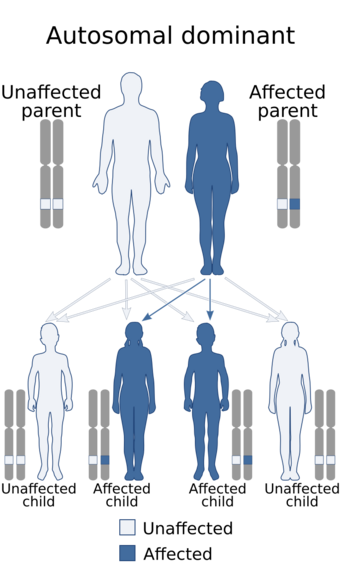Medicine:Polydactyly-myopia syndrome
From HandWiki
| Polydactyly -myopia syndrome | |
|---|---|
| Other names | Czeizel-Brooser syndrome |
 | |
| Specialty | Medical genetics |
| Symptoms | Polydactyly with progressive myopia |
| Complications | Vision impairment |
| Prevention | none |
| Prognosis | Medium |
| Frequency | very rare, only 9 cases have been reported in medical literature |
| Deaths | - |
Polydactyly-myopia syndrome, also known as Czeizel-Brooser syndrome, is a very rare genetic disorder which is characterized by post-axial polydactyly on all 4 limbs and progressive myopia.[1] Additional symptoms include bilateral congenital inguinal hernia and undescended testes.[2] It has only been described in nine members of a 4-generation Hungarian family in the year 1986.[3][4][5][6] This disorder is inherited in an autosomal dominant manner.[7][8]
References
- ↑ "Polydactyly-myopia syndrome (Concept Id: C1868117) - MedGen - NCBI" (in en). https://www.ncbi.nlm.nih.gov/medgen/357424.
- ↑ "Polydactyly-Myopia Syndrome" (in en). http://www.dovemed.com/diseases-conditions/polydactyly-myopia-syndrome/.
- ↑ RESERVED, INSERM US14-- ALL RIGHTS. "Orphanet: Polydactyly myopia syndrome" (in en). https://www.orpha.net/consor/cgi-bin/OC_Exp.php?lng=EN&Expert=2917.
- ↑ "OMIM Entry - 174310 - POLYDACTYLY, POSTAXIAL, WITH PROGRESSIVE MYOPIA" (in en-us). https://omim.org/entry/174310#1.
- ↑ Czeizel, A.; Brooser, G. (2008-04-23). "A postaxial Polydactyly and progressive myopia syndrome of autosomal dominant origin" (in en). Clinical Genetics 30 (5): 406–408. doi:10.1111/j.1399-0004.1986.tb01898.x. PMID 3802559. https://onlinelibrary.wiley.com/doi/10.1111/j.1399-0004.1986.tb01898.x.
- ↑ "Polydactyly myopia syndrome - About the Disease - Genetic and Rare Diseases Information Center" (in en). https://rarediseases.info.nih.gov/diseases/4413/polydactyly-myopia-syndrome.
- ↑ "Polydactyly myopia syndrome – Rare Hematology News" (in en-US). https://www.rarehematologynews.com/rarediseases/polydactyly-myopia-syndrome/.
- ↑ Czeizel, A.; Brooser, G. (November 1986). "A postaxial polydactyly and progressive myopia syndrome of autosomal dominant origin". Clinical Genetics 30 (5): 406–408. doi:10.1111/j.1399-0004.1986.tb01898.x. ISSN 0009-9163. PMID 3802559. https://pubmed.ncbi.nlm.nih.gov/3802559/.

